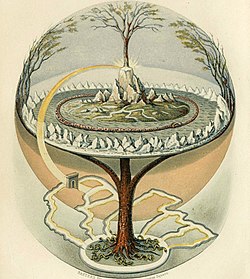
Back اولو قايین AZB Wejdnbaam BAR Световно дърво Bulgarian Světový strom Czech Ама йывăççи CV Verdenstræ Danish Weltenbaum German Árbol del mundo Spanish Ilmapuu Estonian درخت جهانی Persian

The world tree is a motif present in several religions and mythologies, particularly Indo-European, Siberian, and Native American religions. The world tree is represented as a colossal tree which supports the heavens, thereby connecting the heavens, the terrestrial world, and, through its roots, the underworld. It may also be strongly connected to the motif of the tree of life, but it is the source of wisdom of the ages.
Specific world trees include Égig érő fa in Hungarian mythology, Ağaç Ana in Turkic mythology, Kenac' Car[1] in Armenian mythology, Modun in Mongol mythology, Yggdrasil in Norse mythology, Irminsul in Germanic mythology, the oak in Slavic, Finnish and Baltic, Jianmu (Chinese: 建木; pinyin: jiànmù) in Chinese mythology, and in Hindu mythology the Ashvattha (a Ficus religiosa).
- ^ Farnah : Indo-Iranian and Indo-European studies in honor of Sasha Lubotsky. Lucien van Beek, Alwin Kloekhorst, Guus Kroonen, Michaël Peyrot, Tijmen Pronk, Michile de Vaan. Ann Arbor: Beech Stave Press. 2018. ISBN 978-0-9895142-4-8. OCLC 1104878206.
{{cite book}}: CS1 maint: others (link)[page needed]